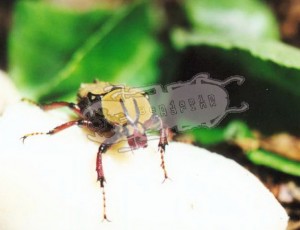This is a breeding report for a species that was formerly known as difficult or impossible to breed. I found that if some measurements are taken, successful breeding and keeping of this species is not too difficult. First, I would like to thank Jack Lee (Taiwan), who made it possible for me to get some pairs of Dicronocephalus wallichi bourgoini. But I have to thank Jahn Oldrich as well, because without his hints a successful breeding of this species would not have been possible.
The first difficulty in breeding is making the females lay eggs. I had them on normal substrate, like for other flower beetles and nothing happened. Only when you are adding fresh leaves (Apple and Plum (Prunus ssp.)) you will get eggs. It is very interesting to see that the females are taking the leaves from the surface, fold them and dig them in. After doing that they are laying one egg in this small „package“. After two to four weeks, the larvae are hatching out. Keeping the larvae poses no problems. I had them on a mixture of leaves and compost, and they were growing quite fast. As I heard quite late of the egg laying trick, I only had two larvae, which turned out to be a pair (Luckily)
The next step that sometimes poses difficulties is to get the larvae through a successful pupation. The trick is that they will only pupate in clay. And it is very important that the layer of clay is under the layer of substrate. As I only had two larvae I took a two litre glass, filled with one litre of clay and one litre of substrate. Take care that the clay is only slightly humid. Too much moisture kills… Ahh, Tomas Libich reminded me that it is good to separate the larvae for pupation, because he found that they were destroying each others’ cocoons… After putting the larvae in, everything I had to do was waiting. I guess, I kept them too warm during pupation, because they were hatching out in January. As I had no fresh leaves, they did not lay eggs, although they were mating.I guess breeding of other Dicronocephalus ssp. is the same, I would be happy if I could try out once. So if you have some overstock, please do write to me, I always welcome exchange… I am always happy for a feedback..
Addition in May 2012: In the last few years the breeding of beetles had made great progress and I would be surprised if there had been no advances in the breeding of Dicronocephalus ssp. Even though I try to keep track of species in breeding, I do not remember having seen any other species or subspecies offered fro sale, or breeding reports for these. If you come across one or have bred one, I would be really happy if you would share your experiences with me. I am quite sure that temperature is also a relevant feature to successfully breed them over multiple generations. I think a hibernation might do them some good.
Addition in July 2012: I have recently managed to get 10 larvae of this species again. Kept them in a leave-wood-flake soil mix. They were growing really fast and pupated within 2 months (received them as late L2). They have pupated in the normal substrate, as I was not fast enough in adding clay to their boxes; I had not expected them to pupate so fast. Anyhow, fingers crossed they master the eclosion.




Leave a Reply